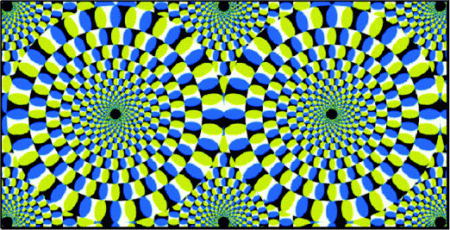
2. Investigate your favorite optical illusion and find out why it works the way it does.
The Rotating Snakes Illusion is a peripheral drift illusion which refers to a motion illusion produced by the appearance of a sawtooth luminance grating in the visual periphery. This illusion of motion is produced by static repeated asymmetric patterns (RAPs) which can cause many people’s visual systems to detect motion when there actually is none. With many visual illusions such as the Rotating Snakes Illusion it is believed that small involuntary eye movements while looking at the pattern play a significant role in producing such illusions. Furthermore, it is believed that such illusions mainly result from fast and slow changes over time in the neuronal representation of contrast-driven RAPs or luminance-driven RAPs. With contrast-driven RAPs such as the Rotating Snakes Illusion, the temporal phase advance in the neuronal response at high contrast can explain the initial, fast motion after each fixation change. The basis behind this explanation is that motion detectors neglect to compensate for the process of neuronal encoding. However, the theory is very complicated and detailed in trying to explain the neurological basis behind the Rotating Snakes Illusion. For detailed information on the illusion here is a link to the article Illusory motion from change over time in the response to contrast and luminance:
Leave a comment